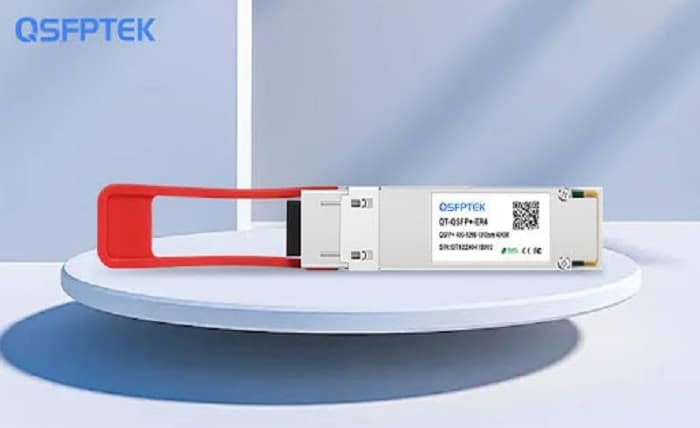Extending Enterprise and Metro Networks with 40G ER4 Optical Transceivers

As data traffic surges across enterprise and metro networks, the demand for reliable, high-capacity optical connectivity continues to grow. While 100G and beyond have taken center stage in hyperscale data centers, 40G still holds considerable value—especially in applications where cost, power efficiency, and deployment simplicity are key. The 40G QSFP+ ER4 optical transceiver offers a compelling solution by providing long-distance transmission (up to 40 kilometers) over single-mode fiber (SMF), making it ideal for enterprise backbones and metro network interconnects. This article explores how the 40G ER4 module plays a vital role in extending enterprise and metro networks, examining its technical characteristics, real-world applications, and deployment considerations.
Understanding the 40G QSFP+ ER4 Optical Transceiver
The 40G ER4 transceiver is based on the QSFP+ standard, which enables compact, high-density port configurations. Unlike typical short-reach 40G modules, the ER4 variant supports long-distance communication—up to 40 kilometers—using coarse wavelength-division multiplexing (CWDM) over standard OS2 single-mode fiber. It transmits four 10G lanes on separate wavelengths (1271 nm, 1291 nm, 1311 nm, and 1331 nm), which are multiplexed within the module and delivered through a single LC duplex interface. Compliant with the IEEE 802.3ba 40GBASE-ER4 standard and equipped with digital diagnostics monitoring (DDM), this transceiver combines performance, compatibility, and management flexibility.
The Role of 40G ER4 in Enterprise Networks
For enterprises with multiple branch offices, campuses, or data centers located across large areas, 40G ER4 offers a scalable and cost-effective solution for building high-speed backbone connections. Rather than aggregating multiple 10G links—which require more fiber runs, more ports, and higher power consumption—an enterprise can deploy a single 40G ER4 link to carry aggregated traffic between locations. This simplifies cabling, reduces network complexity, and frees up switch ports for other uses.
40G ER4 is also ideal for data center interconnect (DCI) within enterprise networks. When two data centers are separated by tens of kilometers, this transceiver enables high-capacity, low-latency communication without the need for complex DWDM equipment. IT teams can easily deploy 40G ER4 into QSFP+ ports of core switches or routers to build a resilient, point-to-point backbone that meets the bandwidth needs of applications such as real-time data replication, remote backup, and high-speed file access.
Leveraging 40G ER4 for Metro Network Deployment
Beyond enterprise campuses, 40G ER4 is equally well-suited for metro networks. In this context, it connects points of presence (PoPs), regional aggregation sites, or service provider edge routers. These deployments typically require stable transmission over distances ranging from 10 km to 40 km, making the ER4’s reach ideal for the task. Unlike DWDM transceivers that require additional Mux/Demux filters, tuning mechanisms, and tight optical power budgets, 40G ER4 offers a plug-and-play alternative that simplifies metro network design.
For telcos and ISPs in metro environments transitioning from legacy SDH or SONET infrastructures, 40G ER4 enables a smooth upgrade path. It provides the high throughput necessary to support modern services like IPTV, VoIP, and cloud access, without the need for complex and expensive optical transport systems. Municipal networks or large industrial zones can also benefit from the ER4’s long-range capability, ensuring reliable interconnectivity between buildings or campuses within a metro area.
Key Advantages of Deploying 40G ER4 Modules
One of the standout advantages of the 40G ER4 transceiver is its ability to cover up to 40 kilometers without external amplification or dispersion compensation, significantly lowering the total cost of deployment. By using CWDM technology and a standard LC duplex connector, it allows for easy integration into existing fiber infrastructure.
Another major benefit is the improved operational efficiency. Compared to using four separate 10G links for the same capacity, a single 40G ER4 module reduces fiber usage and power draw, while simplifying network design and maintenance. It also offers higher port density—critical for environments with limited space in equipment racks or cable trays.
Furthermore, most QSFP+ switch ports are compatible with ER4 modules, meaning businesses don’t need to invest in entirely new hardware to achieve long-distance connectivity. This plug-and-play compatibility enables a cost-effective upgrade path, helping enterprises and service providers meet evolving bandwidth requirements without overhauling their entire network.
Considerations for Successful Deployment
While 40G ER4 is relatively straightforward to deploy, there are several factors to consider for optimal performance. First, ensure that your network uses high-quality OS2 single-mode fiber to minimize attenuation over long distances. Poor quality or improperly terminated fibers can introduce signal loss that exceeds the receiver’s power threshold, leading to packet drops or link instability.
Second, not all switches or routers support ER4 transceivers out of the box. It’s essential to verify compatibility with the switch manufacturer or opt for third-party ER4 modules that are coded specifically for your equipment. Additionally, consider the use of digital diagnostics monitoring (DDM) to track parameters like temperature, optical power, and voltage in real time, allowing for proactive network maintenance.
Finally, since the 40G ER4 transmits four wavelengths, alignment and cleaning of LC connectors become even more critical. Any contamination on the fiber end-face can cause insertion loss or reflection, which degrades performance. Proper fiber hygiene and high-precision patch cords are essential in long-distance, high-speed optical deployments.
Conclusion
The 40G QSFP+ ER4 optical transceiver remains a valuable asset in both enterprise and metro networks. Its long reach, high bandwidth, and ease of deployment offer an ideal balance for businesses that require robust connectivity without the cost and complexity of next-generation optical systems. Whether extending communication between branch offices, connecting metro aggregation points, or enabling efficient data center interconnects, 40G ER4 continues to deliver exceptional performance and return on investment. As organizations strive to expand and modernize their networks, adopting ER4 modules is a smart and sustainable step forward.





